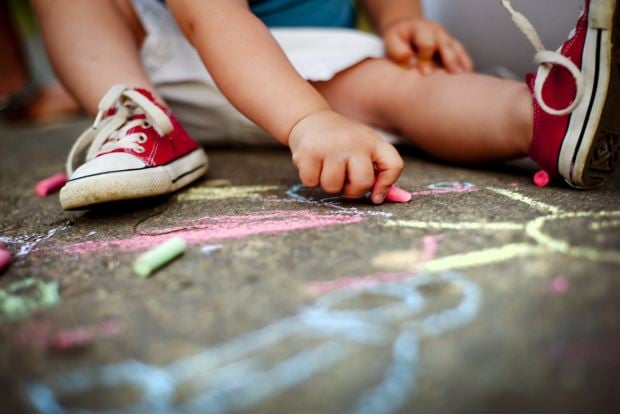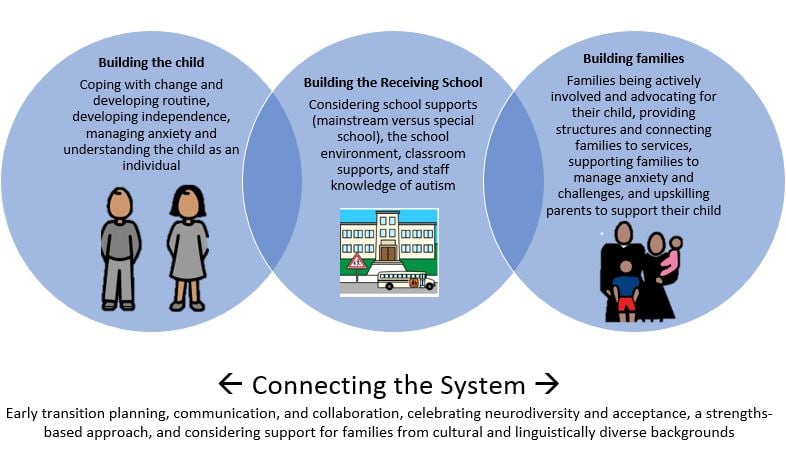 In this blog, Speech Pathology Lead Aria May looks at the transition to school for autistic children.
In this blog, Speech Pathology Lead Aria May looks at the transition to school for autistic children.
The transition to school can be an exciting but also uncertain time for children and families. We know many autistic children may be more sensitive to transitions so may need some extra supports at this time.
School transitions are impacted by many factors including child-specific and external factors. In the SCERTS model which we use at CliniKids, we relate this back to Transactional Supports, which are the interpersonal and learning supports in place that help children achieve their goals.
There is a growing interest in looking at the factors - both positive and the barriers - that influence school transition for autistic children. A recent study (Chen et al 2020) used focus groups and interviewing methods to look at the perspectives of Australian families and early intervention staff on school transition and readiness. Researchers looked at participants’ responses and found four themes that supported successful transitions including building the child, as well as building families, schools and connecting the system (the Transactional Supports). These themes emphasise the importance of the people and environment a child interacts with as well as child-related goals.
The study’s themes within successful school transitions are summarised in the diagram below:

Top tips for the holiday to school transition
Consider your child’s unique strengths and needs - Use a strengths-based approach that is individual to your child. You could consider making an ‘About Me’ profile and sharing it with the school. This could be a page or book that explains to the school who your child is. You can include photos and words describing your child’s interests, how they learn best, their communication style, sensory preferences, or anything that helps others connect and get to know your child.
It’s never too early - You may like to create a countdown calendar showing how many sleeps/ days are left until the return to school. This is something you and your child can look at every day and tick the days off, to show how long is left until the return to school.
It’s a team effort - Collaboration and coordination between key stakeholders (your child’s early intervention team, your family, school, and others) is essential. Parents have an important role in advocating for their child’s transition and you may find you have to get the ‘transition ball’ rolling. Consider sending a group email out to all the important people involved in the transition to start this collaborative process before school ends in Term 4. Open and clear communication is important so clarify what expectations are for everyone involved.
Imagine your dream transition! - Think about what a successful transition would look like for your child and family. This may form a ‘vision’ of your hopes and goals for your child’s experience at school.
You can share your vision at your child’s school transition planning meeting. You may wish to consider these broad goals when thinking about your vision:
- your child’s enjoyment and interest in school
- access to appropriate learning opportunities and working towards independence
- opportunities to interact with peers, education staff and broader community connections
- making friends
- participation in leisure opportunities,
- a sense of wellbeing, belonging and inclusion
(Hirst et al., 2011; Reimagine Australia, 2020)
Talk about it – Something that can help many children is preparing them by talking about upcoming events and experiences. You can start with focusing on what things might be the same (for example, you can still have your favourite snack and drink bottle, we still have swimming on Mondays), and you can also talk about what things are different. Your child may be more of a visual learner and could also be supported by a social story about school. You may have photos of your child’s teacher or the school environment that you could look at together or look at the school website. If possible, you can even visit the school. Big feelings are normal - talk about how your child is feeling and normalise some of these feelings.
Setting up routines – Think about morning and afternoon routines, and what steps or activities your child will need to do to get ready to go to school. You can use a visual schedule if this is a support that your child responds to. Other children may benefit from having a transition object – something from home that they can pack in their schoolbag to help them feel more comfortable.
It’s all about the Zzzzzs – Sleep impacts on everything we do including our ability to engage and learn at school and even our mood. If your family’s sleep routines have changed for the holidays try and incrementally move towards consistent bed and wake-up times around two weeks before starting school. Think about general sleep hygiene including reducing screen time before bed, having a set bedtime, and doing some relaxing activities like cuddling or reading a story (Mindell, Jodi & Williamson, 2018). Periods of transition can be generally exhausting, and you may find your child needs extra sleep at these times.
Self-care for all – Periods of change can be exhausting for parents and caregivers too. Think about the things that support your wellbeing or the people you can ask for help. Acknowledge any strong emotions the transition brings up for you. Everyone feels different - it may be the first time your little one has been away for you for such a prolonged period, or you may be excited for this new chapter in your child’s life.
Remember, transitions take time, and all children go through a period of settling into new routines and experiences, but there are some Transactional Supports we can use to support your child at these times. We hope that this post encourages conversation within your family about what supports may work for your child and that you have a positive transition back to school or to start school for the first time.
References
Chen N, Miller S, Milbourn B, Black MH, Fordyce K, Van Der Watt G, Alach T, Masi A, Frost G, Tucker M, Eapen V, Girdler S. "The big wide world of school": Supporting children on the autism spectrum to successfully transition to primary school: Perspectives from parents and early intervention professionals. Scand J Child Adolesc Psychiatr Psychol. 2020 Aug 11;8:91-100. doi: 10.21307/sjcapp-2020-009. PMID: 33520781; PMCID: PMC7685497.
Hirst M, Jervis N, Visagie K, Sojo V, Cavanagh S. Transition to primary school: A review of the literature. Canberra, Australia; 2011.
Reimagine Australia, Ready. Set. School! Guide for Parents and Carers, Australia, 2020 https://re-imagine.com.au/practitioner/transition-to-school/
Nuske, Heather Joy et al, ‘Broken Bridges—new School Transitions for Students with Autism Spectrum Disorder: A Systematic Review on Difficulties and Strategies for Success’ (2019) 23(2) Autism 306
Mindell, Jodi A and Ariel A Williamson, ‘Benefits of a Bedtime Routine in Young Children: Sleep, Development, and Beyond’ (2018) 40 Sleep medicine reviews 93
Gilson, Kim-Michelle et al, ‘Enhancing Support for the Mental Wellbeing of Parents of Children with a Disability: Developing a Resource Based on the Perspectives of Parents and Professionals’ (2018) 43(4) Journal of intellectual & developmental disability 463
